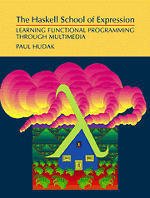Description
The Haskell School of Expression
Learning Functional Programming through Multimedia
Author: Hudak Paul
This book teaches functional programming using Haskell and examples drawn from multimedia applications.
Language: English
Subject for The Haskell School of Expression:
Approximative price 53.83 €
Subject to availability at the publisher.
Add to cart
Programming in Haskell (paper)
Publication date: 02-2000
382 p. · 17.8x25.4 cm · Paperback
Publication date: 02-2000
382 p. · 17.8x25.4 cm · Paperback
Approximative price 105.47 €
Subject to availability at the publisher.
Add to cart
Programming in Haskel
Publication date: 02-2000
384 p. · 17.8x25.4 cm · Hardback
Publication date: 02-2000
384 p. · 17.8x25.4 cm · Hardback
Description
/li>Contents
/li>
Functional programming is a style of programming that emphasizes the use of functions (in contrast to object-oriented programming, which emphasizes the use of objects). It has become popular in recent years because of its simplicity, conciseness, and clarity. This book teaches functional programming as a way of thinking and problem solving, using Haskell, the most popular purely functional language. Rather than using the conventional (boring) mathematical examples commonly found in other programming language textbooks, the author uses examples drawn from multimedia applications, including graphics, animation, and computer music, thus rewarding the reader with working programs for inherently more interesting applications. Aimed at both beginning and advanced programmers, this tutorial begins with a gentle introduction to functional programming and moves rapidly on to more advanced topics. Details about progamming in Haskell are presented in boxes throughout the text so they can be easily found and referred to.
1. Problem solving, programming and calculation; 2. A module of shapes: part I; 3. Simple graphics; 4. Shapes II: drawing shapes; 5. Polymorphic and higher-order functions; 6. Shapes III: perimeters of shapes; 7. Trees; 8. A module of regions; 9. More about higher-order functions; 10. Drawing regions; 11. Proof by induction; 12. Qualified types; 13. A module of simple animations; 14. Programming with streams; 15. A module of reactive animations; 16. Communicating with the outside world; 17. Rendering reactive animations; 18. Higher-order types; 19. An imperative robot language; 20. Functional music composition; 21. Algebraic properties of multimedia; 22. Interpreting functional music; 23. A tour of the prelude list module; 24. A Tour of Haskell's standard type classes.
© 2024 LAVOISIER S.A.S.




